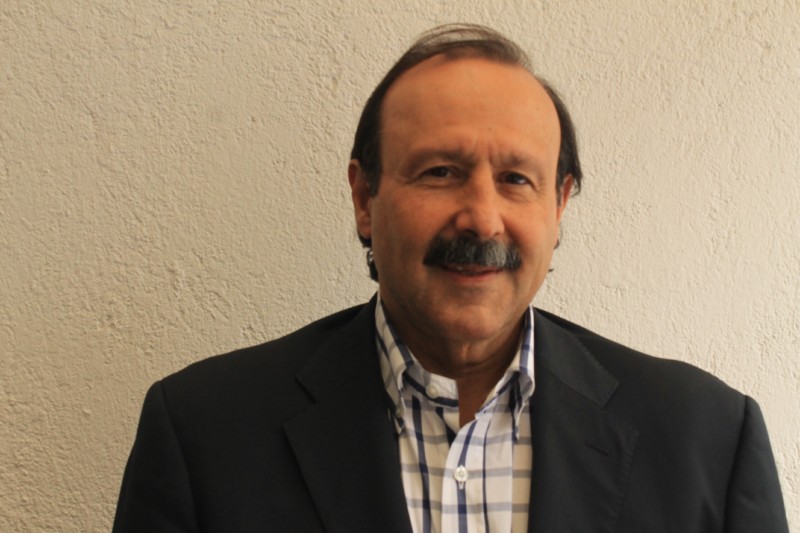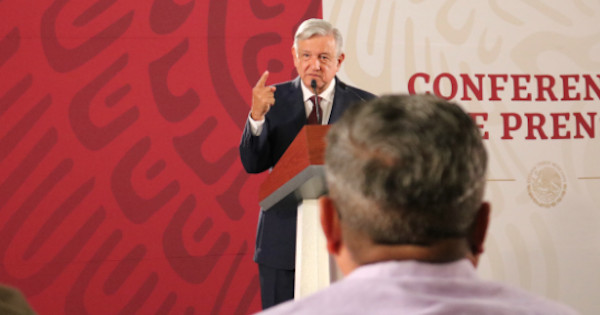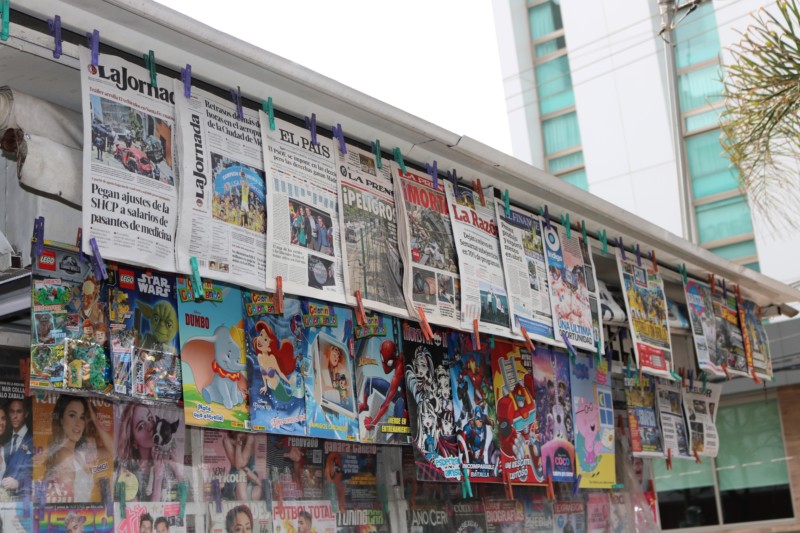Jesús Cantú, the information chief for Andrés Manuel López Obrador, Mexico’s president, wakes up every morning at 4:30 am. He spends an hour or two reviewing the previous day’s news, including Donald Trump’s tweets. Then he takes a shower and hails a taxi. At 6:15, Mexico City’s notorious traffic hasn’t started yet, so Cantú is at the National Palace by 6:30, just in time to set up for the president’s daily morning press conference, the mañanera.
The mañaneras can have an oddly lethargic effect. The early start time is partially responsible. One morning in June, as reporters streamed into the main hall, a reporter described with a guttural “arghh” what it was like to cover them. Just as much to blame, though, is the slow cadence of López Obrador, known as AMLO, who rode into office in 2018 on a torrent of anti-elite—and anti-press—sentiment. The mañaneras tend to push two hours.
AMLO took the stage at 7:15. Standing to the side was Cantú, 67 years old, with a blazer and moustache that gave him the look of a tenured professor. He seemed tense. “There are some moments that I wouldn’t call difficult, but complicated,” Cantú says. When they’re not sleepy, the mañaneras can quickly turn contentious; if AMLO gets a critical question, he’ll cite incorrect data, get lost on tangents, or attack journalists. Last spring, for example, after a heated exchange with Univision’s Jorge Ramos over Mexico’s murder rate, AMLO told reporters, “If you step out of line, you know what will happen. But it won’t be me, it’ll be the people.”
AMLO’s language—which unleashes mobs of social media attacks—mirrors President Trump’s, but the consequences here are more violent. Mexico is the most dangerous country in the world to be a journalist, with more than 150 journalists killed since 2000 and twelve since AMLO took office. Nevertheless, Cantú will argue, AMLO is an improvement over Enrique Peña Nieto, his predecessor, who held only two press conferences during his tenure and ran a surveillance program targeting reporters.
But the Mexican press faces two fearsome threats: one visible—narco-violence and the unwillingness of officials to prosecute crimes against journalists—and the other less so. Cristina Ruelas, the Mexico and Central America director of Article 19, a global NGO dedicated to freedom of expression, calls the latter “economic violence.” Historically, national outlets have relied on publicidad oficial (public advertisement funding) for as much as sixty percent of their budgets and, according to Article 19, the number has been even higher for local publications. Under Peña Nieto, the government spent more than three billion dollars on advertising; when AMLO took office, he announced a fifty percent reduction as part of austerity cuts designed to combat corruption, spurring mass media layoffs. “AMLO is destroying the press as we know it,” Viridiana Ríos, a columnist and frequent guest on Es la hora de opinar, a popular talk show, tells me. That said, she adds, “The press as we know it was not necessarily the press as we want it to be.”
Over the years, officials have often used the public-funding arrangement to curb journalistic independence. “The newspapers, radio stations, and television stations were instruments of the political groups in power,” Luis Guillermo Hernández, an independent journalist, says. He’s working with Ruelas and others to develop a plan for a more transparent system. AMLO, however, has used the corruption of the past to score points with his base at the expense of legitimate reporting. When the summer began, a government agency sent a list of thirty-six prominent journalists to Reforma—a national newspaper alternately described as the Mexican New York Times or Fox News, depending on who’s talking—that was meant to publicize who had received ad funding from the previous administration. Yet the list, compiled by the AMLO administration, represented only a fraction of the total, and many publicly questioned why their names had been included. The implication was that those singled out were chayoteros, a derogatory term for reporters on the government payroll.
On the day of this mañanera, the resentment level was high, and Cantú wasn’t sure what to expect. It was up to him to serve as the conduit between journalists and the administration, a job that was becoming increasingly difficult. Even the mañaneras themselves, journalists had realized, were a false gesture, designed to fill a void left by publicidad oficial. “It’s a self-serving exercise that feeds a narrative of openness,” Javier Garza Ramos, a journalist in Torreón, tells me. “When the media is obliged to cover a morning conference, what does the government need to advertise for?”
That morning, Cantú was relieved to watch as AMLO kept his answers relatively civil, his political charm on full display. It would be a quiet day. When a reporter asked him about the ongoing tariff wars with Trump, AMLO gave a smile before flashing a peace sign, Nixon-style. “Soy el dueño de mi silencio,” he said. “I am the owner of my silence.”
Before Cantú became AMLO’s information chief, he was a journalist. “I was practically born between printing presses and linotypes,” he tells me. In 1919, his grandfather founded El Porvenir, a newspaper in the northern Mexican state of Nuevo León, and his father went on to run it. Cantú studied economics at the Monterrey Institute of Technology and briefly as a postgraduate, but journalism beckoned. His ambition, he says, was “to contribute to the development of a more just and open society.”
He joined the family newspaper, went on to a number of reporting jobs, and eventually became El Porvenir’s publisher. He spent ten years there, until 1992, when he moved to Culiacán—a city that became synonymous with Joaquín “El Chapo” Guzmán’s Sinaloa cartel—to be the editorial director of Noreste.
At the time, it was the reign of the Institutional Revolutionary Party (PRI), which had subjected Mexico to single-party rule since 1929. One of its methods for retaining power was El Chayo: bribing Mexican media with envelopes of cash in exchange for positive coverage, later formalized as publicidad oficial. Both Porvenir and Noreste received publicidad oficial, though Cantú says the threat of withholding ad revenue didn’t affect his work; he believed that the press “was necessary to demonstrate the absence of democracy.” At Noreste, he revealed the excessive salaries of government officials and helped uncover extrajudicial executions.
In 1994, AMLO ran for his first political office—governor of his home state of Tabasco. Originally a member of the PRI, he defected to the newly formed Party of the Democratic Election (PRD) in 1988 after a presidential election that was widely regarded as having been rigged in PRI’s favor. AMLO lost the race, the first in a string of contested elections, but his national profile began to build. A “social fighter,” as Cantú saw him, AMLO’s causes included election reform and human rights. He led a 2,000-strong “caravan for democracy” from Tabasco to Mexico City to protest electoral fraud and later appeared on the cover of the magazine Proceso, arms crossed and shirt bloodied, after blockading new oil wells to protect indigenous communities.
That year, convinced that Mexico’s biggest problem was corruption and rampant electoral fraud, Cantú left his newsroom to take a job as an adviser for the Federal Electoral Institute. In his new role, he met AMLO, a brash but honest figure, Cantú thought, with an awareness—unique among Mexican politicians—of class inequality. Cantú watched in 2000 as AMLO ran for mayor of Mexico City—the last race he would win until the presidency—and when, a few years later, he became a target of attack by the conservative PAN party as it swept into national power. AMLO, already distrustful of the Mexican elite, became increasingly so. “To hell with the institutions,” he said in 2005.
In 2006, AMLO ran for president for the first time, against Felipe Calderón. By then, Cantú had moved on from his electoral post to lead a political science master’s program in Monterrey and write a column for Proceso. He followed the election closely and, when AMLO lost by half a percentage point, he sensed that something was amiss. “It was an election filled with many, many irregularities,” Cantú recalls. Afterward, there were widespread allegations of fraud: powerful companies had run illegal attack ads against AMLO and thousands of voters had disappeared from the electoral roll; the databases, it turned out, were run by a company owned by Calderón’s brother-in-law. More than fifty percent of the country’s 130,000 polling stations reported irregularities. Worst of all, in Cantú’s eyes, electoral authorities skirted their responsibility to investigate.
For AMLO, the results were proof that the system was stacked against him, especially the media. He declared himself the “legitimate president” and began to hold rallies around the country. At one, AMLO pointed at Emiliano Ruiz Parra, a young reporter for Reforma whose coverage he disliked, and said, “There is Reforma, the official bulletin of the PAN, the official bulletin of the Right.” Another time, AMLO said that Ruiz Parra’s presence meant that “our movement has not been extinguished, as our adversaries want.”
In 2012, AMLO ran for president again, facing challengers from both the PRI (Enrique Peña Nieto) and the PAN (Josefina Vázquez Mota). This time, Cantú conducted a media study of the race, finding that, while newspapers generally reflected the pluralism of the country, television networks were highly biased. Some seventy-six percent of Mexicans were informed about politics through television, with ninety-seven percent of the audience tuning into Televisa and TV Azteca. Cantú found that, during the campaign, AMLO received significantly more negative coverage than the other two candidates did, despite polling second. “It is confirmed that the Mexican mass media is not ‘politically neutral,’” Cantú concluded, “and therefore, despite the intentions of legislators and electoral authorities, internal pluralism… has not been achieved.” AMLO lost again.
Up until then, Cantú had stayed apolitical. He respected AMLO’s social consciousness, but was bothered by his derisive nicknames for opponents; at a rally in 2006, for instance, AMLO famously told President Vicente Fox to “Cállate, chachalaca” (“Shut up, chatterbox!”). When AMLO geared up for his 2018 campaign and invited Canú to join, as spokesman, the decision to say yes was ultimately about the opportunity to bring change, Canú tells me. “The country was sitting on a powder keg,” he says; more than forty percent of the population was living in poverty. After having been a reporter, an electoral authority, and an academic, his role would mean “closing a circle that allowed me to have 360 degree vision of the electoral process.” He believed, too, that he could repair the “perverse relationship” between the government and the media.
Many journalists point out that AMLO became president with the support of investigative reporting—outlets such as Sin Embargo, Animal Político, Quinto Elemento, and even Reforma uncovered corruption in Peña Nieto’s administration. “Sometimes I consider it very paradoxical that López Obrador now is complaining about the critical and independent press when that critical and independent press contributed so much to forge the climate of rejection toward the previous regime,” Garza, the reporter in Torreón, says.
AMLO did seem to forge a friendship with the TV networks—the chairman of TV Azteca would sit on his council of business advisors; when Jared Kushner visited Mexico, in March, he dined with AMLO at the home of Bernardo Gómez Martínez, the co-CEO of Grupo Televisa. But as Ruiz Parra says, the president “didn’t change his vision of the press, only his allies.” Toward print publications, AMLO remained a consistent bully, both in terms of rhetoric and policy.
In June, AMLO decided not to attend a summit hosted by the Committee to Protect Journalists at Mexico City’s National Museum of Anthropology. (On the day, AMLO was across town, tweeting that he was videoconferencing with Mark Zuckerberg.) In his place, he sent several representatives, including Cantú. AMLO’s absence permeated the event, and panelists surged with anger and frustration. “The only way to save the lives of journalists is to make the institutions work, to have investigations done, and to have the government act like a government,” Anabel Hernández, who covers cartel violence, told the crowd.
For the last panel of the day, Cantú took the stage, for a discussion on “the media and the state.” During his opening remarks, he affirmed his support of the press. “If we aspire to be a developed country and to construct a democracy, we need an open, independent, and pluralistic media system,” he said. To Cantú’s immediate right, Daniel Moreno, of an outlet called Animal Político, watched him warily, arms and legs crossed.
Cantú visibly felt the hostility, often raising his voice as if anticipating a counterargument. “We have to end the impunity, which is fundamental for ensuring freedom of expression,” he said, of the government’s historic failure to investigate crimes against journalists. “We have to do a thorough review of the laws.” Moreno and Ruelas, of Article 19, who was also onstage, looked skeptical. At one point, Cantú, responded to complaints from Moreno, including the list of journalists who had allegedly received government advertising. “No journalist can say that AMLO has taken any action that diminishes their freedom of expression,” he said. Moreno raised his hands in frustration.
After Cantú finished, Moreno took the mic and faced him. “Have you seen Chernobyl?” he asked. Cantú and the audience laughed. Moreno wasn’t joking. In the HBO series Chernobyl, he continued, there’s a scene in which the head of the KGB says to a scientist, “Trust, but verify.” Moreno went on to say that, when he listens to Cantú speak about what the administration promises, “We have to verify if they’re actually going to do it. Because I would say in the first six months, this has not been the case.”
When I catch up with Cantú several months later, he says, “regrettably, there has not been the best progress.” Since the summit, four journalists have been killed, and Moreno’s words have increasingly come to define the dynamic Cantú must manage. Over the summer, the United Nations completed a review of press security in Mexico and shared a set of policy recommendations with the government; AMLO has yet to implement them. In August, the administration signed an agreement with UNESCO to support investigative journalism, but any follow-through is, at best, months away. Cantú tells me that the administration is working on a plan “to address the structural causes that are creating the threats and conditions of insecurity,” though he’s vague about what, exactly, that entails, and argues that it should not be entirely up to the government to solve the media industry’s problems. “If it were just the government, that would be contradictory,” he tells me. “The government alone cannot create a pluralistic, independent, and professional ecosystem.”
Journalists are weary of these lines. Narco-wars are escalating, and AMLO’s approval rating is plummeting. In November, the UN and Inter-American Commission on Human Rights released a joint statement denouncing Mexico for being too slow in its investigation into the death of a reporter named Javier Valdez Cárdenas, calling it “inadmissible” and a possible violation of the right to justice. AMLO has continued to attack the press, comparing journalists to dogs and accusing them of “biting the hand that removed their muzzle.” His supporters have followed his lead; after a speech celebrating his first year in office, AMLO’s fans swarmed around a TV Azteca reporter, chanting, “Chayotero, chayotero.”
Nevertheless, Cantú continues to stand by the president. “The relationship between the government and the media has not been the best,” he says, but it can be mended. Cantú still considers himself a journalist. He’s been a victim of the old practices of the Mexican government—conditions that make it “absolutely impossible to practice journalism,” he says—and he believes that the administration has laid the groundwork for repairing freedom of the press. “We are taking steps in the right direction,” Cantú tells me.
Cantú understands that his relationship with journalists is inherently fraught—it’s their responsibility to demand more from the government as long as solutions don’t materialize. “Only one thing will restore confidence,” he says. “It’s not going to be promises or good intentions. We have to work with them, and we have to respond with facts. It’s the only way we’re going to regain trust.”
Funding to support this piece came from New York University Journalism, the NYU Center for Latin American & Caribbean Studies, and the Gumroad Creators Fund.
Leo Schwartz is a freelance journalist and graduate student. His work has appeared in The Nation, PBS NewsHour, BuzzFeed News, and Roads & Kingdoms, and he is currently the web editor at the North American Congress on Latin America (NACLA) Report.




